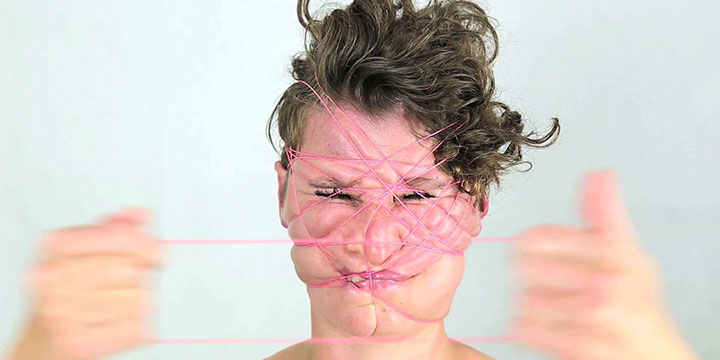Nicole Büsing and Heiko Klaas recommend five videos from the exhibition “Antarctica” at the Kunsthalle Wien
In her book “Entfremdung. Zur Aktualität eines sozialphilosophischen Problems“ (Alienation. A Contemporary Problem of Social Philosophy), published in 2016, the Swiss philosopher Rahel Jaeggi outlined the phenomenon of the objectification of interhuman relationships and the relations with the world as follows: “Alienation is a relationship based on the absence of a relationship”. Is alienation thus a new phenomenon of contemporary life? The literature of the past turn of the century had also repeatedly addressed the issue of isolation and the lack of relationships within society, for example, in Arthur Schnitzler’s theatre piece “The Lonely Way”, (1903), which recently played in a grandiose staging at the Theater in der Josefstadt in Vienna. Equally worth seeing was the group show “Antarctica. An Exhibition on Alienation”, also presented in Vienna during the past winter season. Departing from a note written by the Italian cult director Michelangelo Antonioni, from the 1960s, referring to a potential glacier melting in the Antarctica and a hint to a film, the two curators from the Kunsthalle Wien, Vanessa Joan Müller and Nicolaus Schafhausen, conceived an exhibition on the topic of alienation and contemporary art. The focus was on the latest contemporary photography and video art by the younger generation of artists. Introduced here are five videos from this show, selected by Nicole Büsing and Heiko Klaas for BLINKVIDEO.
Serving as a basis for the six-minute video work “Afterwork” (2016) by the Lithuanian artist duo Vilte Braziunaitè and Tomas Sinkevicius was the so-called “stock photography”. Laid over the aesthetically staged, glossy images of automobile hoods, flora and fauna illuminated by evening light along with various amorph-looking objects we hear a disparate, emphatic off-scene voice. Similar to the images originating from pre-produced, unreal visualizations for advertising purposes, the commentary was assembled from footage deriving from tweets and chatbots of various social media groups. The discrepancy between the subject and his performance in an artificially construed public “after-work situation” is impressively illustrated in the video. Hovering above it all is a longing for closeness, emotional comfort and meaning, symbolized by the image of a necklace floating in mid-air, which is set against the null and void fantasy images in “Afterwork” as a concrete object.
The “brave new world of work” also plays a role in Burak Delier’s 15-minute video “Crises & Control” of 2013. Here, performers are seen intently practicing yoga exercises in a modern building in Istanbul. The physical exercises for relaxation executed in tight business attire are overlaid with the performers’ comments about stress at the office, tensions in the working world, success and failure in one’s career and other business-related subjects. The Turkish artist, born in 1977, creates a tension between two worlds: on the one hand, the balancing, stress-relieving world of yoga, usually associated with the leisure-oriented domain of fitness and wellness studios, and, on the other hand, the world of business, careers and everyday work. In Delier’s case, even relaxation, paradoxically, is stringently organized down to the last detail: external recreational areas no longer exist; the credo “fit for the job” is fully integrated into the office routine, the privilege of taking a little time off transferred into zones within the office world. Neoliberalism and late capitalism engross the individual, who is forced to place self-optimization in the service of his or her career. But at which price?
The artist Isabella Fürnkäs was born in Tokio in 1988 and currently lives and works in Berlin and Düsseldorf. On view in the exhibition “Antarctica” was, alongside an installation and a performance, a video loop of around three minutes, titled “In Ekklesia” from 2015. Images of industrial assembly robots and drawn comic figures, accompanied by hard rave beats, are shown at a rapidly alternating pace. Commenting text lines will pop up again and again, such as: “I’m so sad.” The viewer experiences an endless loop of repetition, rhythm, monotony and the co-optation of the individual. The title of the work “In Ekklesia”, by the way, refers to the core of the Attic democracy of antiquity. Isabella Fürnkäs asks us which position the responsible citizen can take while risking to be worn down in the friction between man and machine, between automat and individual.
An entirely different sphere is examined by the artist Jana Schulz, born in Berlin in 1984, who studied at the Academy of Fine Arts in Leipzig. In her 17-minute video work “Golden Boys. Igdir. Maravilla. Monterey Park” from 2018 she observes, in long takes, young men in the environs of the world of boxing. In the scope of research trips to three places in Turkey and Los Angeles, Jana Schulz filmed her protagonists during unproductive leisure activities such as watching TV, playing with their cell phone, intensive body care or sports training. Choosing settings in economically precarious locations, she scrutinized – in a kind filmic sociological study – the subcultural milieu of boxing, which has been a particular object of fascination for many decades, and not only with regard to sports. The video’s title “Golden Boys” is drawn from the company name “Golden Boys Promotion” held by a US-American boxing agency.
Another highly convincing video work is the 29-minute film “Roosenberg”, created in 2017 by the Estonian Ingel Vaikla, born in 1992 and living in the Belgian city of Ghent. The eponymous Roosenberg Abbey is an abbey that was re-established in Waasmunster, Belgium in a minimalist style devoted to architectural modernity. The video is a portrait of this abbey and the last four of its inhabitants. The austerely dressed sisters are seen performing their habitual tasks during the last days before the abbey’s closure. Religious rituals blend with routine activities such as packing, cleaning up and preparing to move out. In long takes and aesthetically remote images, the video describes the inner world of monastic life within an unpretentious architectural setting detached from the outer world. Special contrasts of light and darkness alternate with calm takes of everyday scenes in which the sisters are captured by the camera in an almost picturesque manner. The site of the abbey acts as a heterotopia in the sense of Michel Foucault: a space defined by a community of faith with a strict set of rules, perceived as a rigorously secluded part of society. The clearly structured, functional rooms built by the architect and Benedictine monk, Hans von der Laan, provide a conceptual framework in which the sisters integrate themselves unconditionally. Religion as alienation – alienation as religion, in no other video at the Kunsthalle Wien was the topic of the exhibition so clearly outlined as in Ingel Vaiklas’ half-hour masterpiece.
Nicole Büsing & Heiko Klaas
June 7, 2019






























